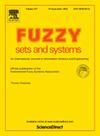随机时滞八元模糊神经网络的几乎自同构动力学
IF 2.7
1区 数学
Q2 COMPUTER SCIENCE, THEORY & METHODS
引用次数: 0
摘要
研究一类具有时滞的随机八元值模糊神经网络(sovfnn)的几乎自同构动力学。利用非分解方法,在不假设激活函数满足全局Lipschitz条件的情况下,分别研究了这类sovfnn在有限维分布中概自同构解的存在唯一性和概自同构解在均方意义上的全局指数稳定性。首先,我们利用Banach收缩原理,证明了sovfnn在合适的完备空间中存在唯一l2 -有界和l2 -一致连续解。然后,我们使用一些不等式技巧来证明这个唯一解在有限维分布中也是一个几乎自同构的解。此外,利用矛盾法建立了该概自同构解的全局指数稳定性。最后,给出了一个算例来验证所得结果。即使SOVFNNs退化为实值神经网络(RVNNs),本文所得到的结果也是全新的。本文章由计算机程序翻译,如有差异,请以英文原文为准。
Almost automorphic dynamics to stochastic octonion-valued fuzzy neural networks with delays
In this paper, we are concerned with the almost automorphic dynamics for a class of stochastic octonion-valued fuzzy neural networks (SOVFNNs) with delays. Using a non-decomposition approach and without assuming that the activation functions satisfy the global Lipschitz condition, we investigate the existence and uniqueness of almost automorphic solutions in finite-dimensional distributions to this class of SOVFNNs and the global exponential stability of the unique almost automorphic solution in mean square sense, respectively. Firstly, we use the Banach contraction principle to establish the existence of a unique -bounded and -uniformly continuous solution of SOVFNNs in a suitable complete space. Then, we employ some inequality tricks to demonstrate that this unique solution is also an almost automorphic one in finite-dimensional distributions. In addition, we establish the global exponential stability of this almost automorphic solution by contradiction method. Finally, we present an example to validate the obtained results. The results gained in this paper are completely new even when the SOVFNNs degenerate into real-valued neural networks (RVNNs).
求助全文
通过发布文献求助,成功后即可免费获取论文全文。
去求助
来源期刊

Fuzzy Sets and Systems
数学-计算机:理论方法
CiteScore
6.50
自引率
17.90%
发文量
321
审稿时长
6.1 months
期刊介绍:
Since its launching in 1978, the journal Fuzzy Sets and Systems has been devoted to the international advancement of the theory and application of fuzzy sets and systems. The theory of fuzzy sets now encompasses a well organized corpus of basic notions including (and not restricted to) aggregation operations, a generalized theory of relations, specific measures of information content, a calculus of fuzzy numbers. Fuzzy sets are also the cornerstone of a non-additive uncertainty theory, namely possibility theory, and of a versatile tool for both linguistic and numerical modeling: fuzzy rule-based systems. Numerous works now combine fuzzy concepts with other scientific disciplines as well as modern technologies.
In mathematics fuzzy sets have triggered new research topics in connection with category theory, topology, algebra, analysis. Fuzzy sets are also part of a recent trend in the study of generalized measures and integrals, and are combined with statistical methods. Furthermore, fuzzy sets have strong logical underpinnings in the tradition of many-valued logics.
 求助内容:
求助内容: 应助结果提醒方式:
应助结果提醒方式:


